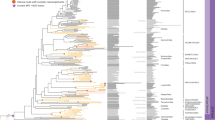Abstract
The bodies of insects consist of a tandem array of segments. Homoeotic genes direct cells in different segments to the appropriate developmental pathways. I have discovered the existence of a cluster of homoeotic genes in the flour beetle Tribolium castaneum that are ordered along the second linkage group in a sequence identical to that of the body segments in which they act. The known domain of function of this homoeotic gene cluster (HOM-C) spans approximately 15 segments in the head, thorax and abdomen. The HOM-C contains at least six complementation groups, including elements with apparent homology to the two major groups of homoeotic genes in Drosophila melanogaster, the Antennapedia complex (ANT-C) and the bithorax complex (BX-C).
This is a preview of subscription content, access via your institution
Access options
Subscribe to this journal
Receive 51 print issues and online access
$199.00 per year
only $3.90 per issue
Buy this article
- Purchase on Springer Link
- Instant access to full article PDF
Prices may be subject to local taxes which are calculated during checkout
Similar content being viewed by others
References
1. Wakimoto, B. T. & Kaufman, T. C. Devl Biol 81, 51–64 (1981). 2. Lewis, E. B. Nature 276, 565–570 (1978). 3. Sanchez-Herrero, E., Vernos, I., Marco, R. & Morata, G. Nature 313, 108–113 (1985). 4. Morata, G., Sanchez-Herrero, E. & Casanova, J. Cell Differ. 18, 67–78 (1986). 5. Karch, F. et al Cell 43, 81–96 (1985). 6. Bender, W. et al Science 221, 23–29 (1983). 7. Kaufman, T. C. in Time, Space and Pattern in Development (eds Jeffery, E. R. & Raff, R. A.) 365–383 (Liss, New York, 1983). 8. Kaufman, T. C. & Abbot, M. K. in Molecular Aspects of Early Development (eds Malacinski, G. M. & Klein, W. H.) 189–218 (Plenum, New York, 1984). 9. Struhl, G. Nature 308, 454–457 (1984). 10. Beachy, P. A., Helfand, S. L. & Hogness, D. S. Nature 313, 545–551 (1985). 11. Garcia-Bellido, A. Am. ZooL 17, 613–629 (1977). 12. Ouweneel, W. J. Adv. Genet. 18, 179–248 (1976). 13. Tazima, Y. The Genetics of the Silkworm (Logos, London, 1964). 14. Sokoloff, A. The Genetics of Tribolium and Related Species (Academic, New York, 1966). 15. Sokoloff, A. The Biology of Tribolium Vol. 3 (Oxford University Press, 1977). 16. Beeman, R. W., Johnson, T. R. & Nanis, S. M. /. Hered. 77, 451–456 (1986). 17. Wool, D. & Medlinger, S. Genetica 44, 496–504 (1973). 18. Sokoloff, A., Ferrone, R. F., Chancy, J. D., Braden, J. & Munoz, R. J. Genome 29, 26–33 (1987). 19. Dawson, P. S. & Berends, K. L. Can. J. Genet. Cytol. 27, 276–278 (1985). 20. Englert, D. C. & Bell, A. E. Can. J. Genet. Cytol. 5, 467–471 (1963). 21. Hoy, M. A. Tribolium Inf. Bull. 9, 85 (1966). 22. Sokoloff, A. Tribolium Inf. Bull 22, 79 (1982). 23. Dawson, P. S. J. Hered. 59, 188–190 (1968). 24. Lasley, E. L. & Sokoloff, A. Tribolium Inf. Bull 3, 22 (1960). 25. Sokoloff, A. Tribolium Inf. Bull 8, 44 (1965). 26. Hoy, M. A. & Sokoloff, A. Tribolium Inf. Bull 7, 48 (1964). 27. Sokoloff, A. Tribolium Inf. Bull 6, 23 (1963). 28. Hoy, M. A. Tribolium Inf. Bull. 9, 90 (1966).
Author information
Authors and Affiliations
Rights and permissions
About this article
Cite this article
Beeman, R. A homoeotic gene cluster in the red flour beetle. Nature 327, 247–249 (1987). https://doi.org/10.1038/327247a0
Received:
Accepted:
Issue Date:
DOI: https://doi.org/10.1038/327247a0
This article is cited by
-
The red flour beetle T. castaneum: elaborate genetic toolkit and unbiased large scale RNAi screening to study insect biology and evolution
EvoDevo (2022)
-
Hox gene expression during development of the phoronid Phoronopsis harmeri
EvoDevo (2020)
-
Hox gene expression in postmetamorphic juveniles of the brachiopod Terebratalia transversa
EvoDevo (2019)
-
Analysis of the Tribolium homeotic complex: insights into mechanisms constraining insect Hox clusters
Development Genes and Evolution (2008)
-
Development of Tribolium castaneum
Development Genes and Evolution (2008)
Comments
By submitting a comment you agree to abide by our Terms and Community Guidelines. If you find something abusive or that does not comply with our terms or guidelines please flag it as inappropriate.



